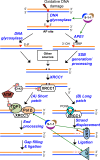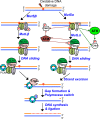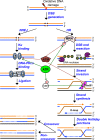Functional interplay between ATM/ATR-mediated DNA damage response and DNA repair pathways in oxidative stress
- PMID: 24947324
- PMCID: PMC4176976
- DOI: 10.1007/s00018-014-1666-4
Functional interplay between ATM/ATR-mediated DNA damage response and DNA repair pathways in oxidative stress
Abstract
To maintain genome stability, cells have evolved various DNA repair pathways to deal with oxidative DNA damage. DNA damage response (DDR) pathways, including ATM-Chk2 and ATR-Chk1 checkpoints, are also activated in oxidative stress to coordinate DNA repair, cell cycle progression, transcription, apoptosis, and senescence. Several studies demonstrate that DDR pathways can regulate DNA repair pathways. On the other hand, accumulating evidence suggests that DNA repair pathways may modulate DDR pathway activation as well. In this review, we summarize our current understanding of how various DNA repair and DDR pathways are activated in response to oxidative DNA damage primarily from studies in eukaryotes. In particular, we analyze the functional interplay between DNA repair and DDR pathways in oxidative stress. A better understanding of cellular response to oxidative stress may provide novel avenues of treating human diseases, such as cancer and neurodegenerative disorders.
Figures







Similar articles
-
DNA damage checkpoint kinases in cancer.Expert Rev Mol Med. 2020 Jun 8;22:e2. doi: 10.1017/erm.2020.3. Expert Rev Mol Med. 2020. PMID: 32508294 Review.
-
JAK Inhibition Prevents DNA Damage and Apoptosis in Testicular Ischemia-Reperfusion Injury via Modulation of the ATM/ATR/Chk Pathway.Int J Mol Sci. 2021 Dec 13;22(24):13390. doi: 10.3390/ijms222413390. Int J Mol Sci. 2021. PMID: 34948185 Free PMC article.
-
Cancer Vulnerabilities Through Targeting the ATR/Chk1 and ATM/Chk2 Axes in the Context of DNA Damage.Cells. 2025 May 20;14(10):748. doi: 10.3390/cells14100748. Cells. 2025. PMID: 40422251 Free PMC article. Review.
-
DNA-PKcs, ATM, and ATR Interplay Maintains Genome Integrity during Neurogenesis.J Neurosci. 2017 Jan 25;37(4):893-905. doi: 10.1523/JNEUROSCI.4213-15.2016. J Neurosci. 2017. PMID: 28123024 Free PMC article.
-
N-nitroso-N-ethylurea activates DNA damage surveillance pathways and induces transformation in mammalian cells.BMC Cancer. 2014 Apr 24;14:287. doi: 10.1186/1471-2407-14-287. BMC Cancer. 2014. PMID: 24758542 Free PMC article.
Cited by
-
APE1 assembles biomolecular condensates to promote the ATR-Chk1 DNA damage response in nucleolus.Nucleic Acids Res. 2022 Oct 14;50(18):10503-10525. doi: 10.1093/nar/gkac853. Nucleic Acids Res. 2022. PMID: 36200829 Free PMC article.
-
Cell Signaling Pathways That Promote Radioresistance of Cancer Cells.Diagnostics (Basel). 2022 Mar 8;12(3):656. doi: 10.3390/diagnostics12030656. Diagnostics (Basel). 2022. PMID: 35328212 Free PMC article. Review.
-
Surgical wound fluids from patients treated with intraoperative radiotherapy induce radiobiological response in breast cancer cells.Med Oncol. 2018 Dec 31;36(2):14. doi: 10.1007/s12032-018-1243-z. Med Oncol. 2018. PMID: 30599057 Free PMC article.
-
Targeting Oxidatively Induced DNA Damage Response in Cancer: Opportunities for Novel Cancer Therapies.Oxid Med Cell Longev. 2018 Mar 27;2018:2389523. doi: 10.1155/2018/2389523. eCollection 2018. Oxid Med Cell Longev. 2018. PMID: 29770165 Free PMC article. Review.
-
Loss of Genome Fidelity: Beta HPVs and the DNA Damage Response.Front Microbiol. 2017 Nov 15;8:2250. doi: 10.3389/fmicb.2017.02250. eCollection 2017. Front Microbiol. 2017. PMID: 29187845 Free PMC article. Review.
References
-
- Sies H. Oxidative stress: oxidants and antioxidants. Exp Physiol. 1997;82(2):291–295. - PubMed
-
- Betteridge DJ. What is oxidative stress? Metabolism. 2000;49(2 Suppl 1):3–8. - PubMed
-
- Jones DP. Redefining oxidative stress. Antioxid Redox Signal. 2006;8(9–10):1865–1879. - PubMed
-
- Agnez-Lima LF, Melo JT, Silva AE, Oliveira AH, Timoteo AR, Lima-Bessa KM, Martinez GR, Medeiros MH, Di Mascio P, Galhardo RS, Menck CF. DNA damage by singlet oxygen and cellular protective mechanisms. Mutat Res. 2012;751(1):15–28. - PubMed
Publication types
MeSH terms
Substances
Grants and funding
LinkOut - more resources
Full Text Sources
Other Literature Sources
Research Materials
Miscellaneous

